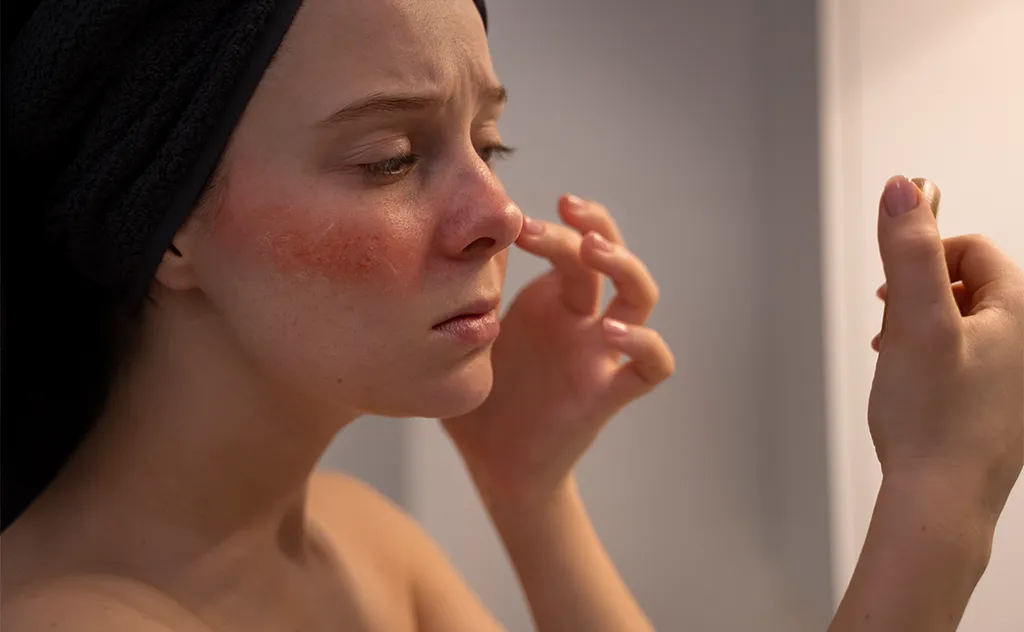With the arrival of winter, our facial skin often becomes the victim of an annoying problem: chapped and reddened skin that compromises its health and appearance.
It generally starts with chapped lips. And if you do not take the right precautions, this disorder can spread to the whole face and cause you some discomfort.
Low temperatures and dry air can deprive the skin of its natural moisture, causing discomfort and noticeable irritation.
To help you solve this unpleasant seasonal inconvenience, we will explore together the best natural remedies for sensitive skin.
We will discover how to protect your skin from the adverse effects of the cold and the environment without resorting to harsh chemicals. From simple tricks in your daily routine to remedies from nature, we will find practical and effective solutions that you can test starting today to keep your facial skin radiant and healthy during the most extreme months of the year.
We start with the causes and end with natural remedies for chapped and red facial skin.
-
Product on sale
 CBD Moisturising Face CreamOriginal price was: £27.00.£18.90Current price is: £18.90.
CBD Moisturising Face CreamOriginal price was: £27.00.£18.90Current price is: £18.90.
Why can the skin on the face become chapped and red?
The skin of the face, which is delicate and exposed to the elements, can be chapped and reddened, a common phenomenon during the winter season.
The causes of chapped facial skin can result from both internal and external factors. Internal factors such as dehydration, nutritional deficiencies or pre-existing skin conditions can contribute to irritation. On the other hand, external agents such as intense cold, dry winds and excessive use of harsh cleansers can compromise the skin barrier, increasing skin sensitivity.
Let’s look in detail at causes and triggers, to understand how to tackle and prevent the harmful effects, thus restoring vitality to facial skin.
Internal causes of chapped skin
Let’s start by trying to understand what are the internal causes that can make a skin more susceptible to redness and dryness.
Here are some of the possible internal causes:
- Dehydration: dehydrated skin lacks flexibility and is therefore more susceptible to cracking;
- Nutrient deficiency: a diet deficient in essential nutrients such as vitamins, minerals and fatty acids can affect skin health (e.g. deficiencies in vitamin A, vitamin E, zinc or omega-3 fatty acids can contribute to dry skin)
- Hormonal problems: changes such as those occurring during menopause or puberty;
- Skin diseases: dermatological conditions such as eczema, psoriasis or seborrhoeic dermatitis;
- Ageing: with ageing, the skin tends to lose its natural elasticity;
- Underlying medical conditions: certain medical conditions, such as diabetes or hypothyroidism, can affect skin health;
- Medications: certain medications, such as those for acne or certain dermatological conditions, can cause dry skin as a side effect.
If your skin is often chapped, not only during the winter, the cause could be among those just listed. Or at any rate, these factors can make your skin more sensitive to external agents.
External causes of chapped skin
External causes of chapped skin can be attributed to environmental and behavioural factors.
You should pay attention to the following external factors:
- Exposure to cold and wind: low temperatures, particularly during winter, and exposure to wind can deprive the skin of its natural moisture;
- Excessive exposure to the sun: the sun’s UV rays can damage the skin and contribute to skin dryness;
- Use of harsh cleansers: some body cleansers can remove the skin’s natural oils, leaving it dry and susceptible to cracking;
- Too hot or frequent washing: hot water can remove natural oils from the skin;
- Poor eating habits: a diet low in essential nutrients, such as vitamins and minerals, can affect the health of the skin;
- Smoking: cigarette smoking can damage the skin;
- Stress: stress can contribute to conditions such as eczema or acne, which in turn can lead to cracking;
- Sudden climatic changes: going from a hot and humid environment to a cold and dry one can put a strain on the skin.
If you notice that your skin only gets dry and red at certain times of the year or in certain situations, then you should look for the cause among external factors. Remember, however, that this disorder can be caused by a combination of internal and external causes.
What does chapped skin look like?
Chapped skin is characterised by an uneven and often rough appearance, with small superficial cracks forming on the skin surface.
Symptoms of dry skin, which may precede or accompany the appearance of cracked skin, include:
- Itching: chapped facial skin and itching are an almost inseparable pair, and can vary from mild to more intense;
- Redness: in the most sensitive areas, blood vessels dilate, giving a reddish, often blotchy appearance;
- Sensation of tightness: dry skin appears as if it were stretched or subjected to pressure;
- Flaking: in severe cases, dry skin can flake, causing small scales or pieces of dead skin to form; flaky skin is also more itchy and susceptible to inflammation;
- Roughness: lack of hydration and care can make the skin rough to the touch;
- Small cracks or fissures: cracks are superficial splits in the skin, which can vary in size and depth;
- Heat sensation: the dilation of blood vessels that causes redness may also be associated with a sensation of heat;
- Bleeding in severe cases: in borderline cases, the cracks may be so deep that they cause bleeding, making the skin vulnerable to infection.
To avoid the most serious symptoms, it is important to address dry skin and chapped skin early on by adopting a proper skin moisturising and protection routine, as well as avoiding triggers such as harsh cleansers or extreme weather conditions.
And now that we understand what the possible causes are, let’s look at what natural remedies for chapped and red facial skin can be.
-
Product on sale
 CBD Moisturising Face CreamOriginal price was: £27.00.£18.90Current price is: £18.90.
CBD Moisturising Face CreamOriginal price was: £27.00.£18.90Current price is: £18.90.
Natural remedies for chapped facial skin?
As soon as you notice that your facial skin becomes chapped, you should take gentle, moisturising care to restore its health and radiance.
Many natural remedies can help soothe dry, chapped skin, providing immediate relief and improving its condition over time. However, it is important to note that every skin is unique, and what works for one person may not be as effective for another.
Also remember that before using any remedy, it is advisable to test it on a small area of the skin to avoid possible allergic reactions.
Below, we suggest some of the main natural remedies for chapped and red facial skin.
1. Vegetable oils
How to flush the skin naturally? A real panacea is dermatologically tested oil for dry skin.
There is a wide choice of natural oils, including olive, almond, grape, lavender, argan, calendula, castor and St. John’s Wort. These oils are known for their emollient, soothing and regenerating properties, providing deep nourishment to the skin.
Almond oil, for example, is rich in vitamins and nutrients that help maintain moisture. Almonds can also be found in cream for chapped facial skin.
Olive oil is valued for its ability to soften and moisturise the skin, while lavender oil is known for its calming properties.
In particular, CBD oil, derived from cannabis, has been the subject of increasing interest for its potential anti-inflammatory and calming properties. CBD cosmetics and different skin types get along particularly well, thanks to the powerful properties of the active ingredient.
-
Product on sale
 CBD Moisturising Face CreamOriginal price was: £27.00.£18.90Current price is: £18.90.
CBD Moisturising Face CreamOriginal price was: £27.00.£18.90Current price is: £18.90.
2. Aloe vera gels
How to get rid of chapped and red skin? Another remedy that has been in vogue for many years is aloe vera gel, in pure concentration.
Aloe vera gel is widely recognised as an effective remedy for dry and itchy skin due to its exceptional moisturising, soothing and regenerating properties. Extracted from the leaves of the aloe vera plant, this clear gel contains a mixture of beneficial compounds, including vitamins, minerals, amino acids and enzymes.
Applied to dry skin, it creates a light but effective layer that helps retain water, thus reducing the feeling of dryness and the appearance of cracks.
The presence of anti-inflammatory substances and cooling agents makes aloe vera gel ideal for relieving discomfort associated with conditions such as sunburn, skin irritation or redness due to environmental factors.
In addition, aloe vera gel can support the skin’s regeneration process. The enzymes present can help remove superficial dead cells, thus promoting the growth of new skin cells and improving the skin’s overall texture.
3. Milk
Milk has historically been considered one of the natural remedies for chapped and red facial skin. Its composition rich in nutrients, proteins, lactic acid and fats is what gives milk its moisturising and soothing properties.
Lactic acid is a mild exfoliating agent that can help remove dead surface skin cells, thus promoting skin regeneration. This can be especially beneficial for improving the texture of dry skin and reducing the appearance of cracks.
Moisturising is another key feature of milk. Applying milk to the skin helps retain moisture, providing immediate relief to dry skin.
You can take advantage of this by preparing a milk-based wash, pack or a milk and honey mask to apply to your face.
4. DIY masks
You can occasionally create face masks to nourish the skin more thoroughly than just daily hygiene.
For dry skin, masks based on:
- Banana: the banana is a fruit rich in vitamins and minerals that can help moisturise and nourish the skin;
- Clay: clay is a natural ingredient that removes impurities from the skin and absorbs excess oil, it is in fact recommended among the natural remedies for dermatitis;
- Avocado: avocado is a fruit rich in healthy fats that can help moisturise and nourish the skin;
- Oats and yoghurt: oats have exfoliating and soothing properties, while yoghurt provides hydration;
- Olive oil and yoghurt: olive oil contains fatty acids that can moisturise the skin;
- Cucumber and mint: cucumber is rich in water and has soothing properties for reddened skin.
Use these masks once or twice a week to keep your facial skin hydrated, nourished and reduce dryness and redness. Test in small areas if you have particularly sensitive skin or suffer from allergies.
5. Water
Drinking plenty of water helps maintain the right moisture balance, promoting the regular function of skin cells.
This is how adequate water intake (at least 1.5 litres a day) improves dry and reddened facial skin:
- Deep hydration: water is the main component of skin cells; drinking allows cells to stay hydrated from the inside and not just the outside;
- Elimination of toxins: helps the body eliminate toxins through the excretion process;
- Increased blood circulation: hydration promotes better blood circulation and consequently less redness;
- Regulation of body temperature: regulates body temperature through perspiration.
In addition to drinking at least 8 glasses of water a day, you should consume hydrating foods such as fresh fruit and vegetables, avoid dehydrating beverages such as coffee and alcohol, and of course never neglect the use of special creams for external hydration.

How to care for your skin every day?
Taking care of your facial skin every day, both in the morning and in the evening, is essential to maintain its health and beauty.
Here is a complete routine you can follow.
In the morning:
- Cleansing: start the day with a gentle cleanser to remove sebum build-up and night-time impurities; this prepares the skin to better absorb other products;
- Toner: apply an alcohol-free toner to restore the skin’s natural pH;
- Antioxidant serum: apply this to protect your skin from damage caused by free radicals, for example from environmental exposure;
- Moisturiser: choose a moisturiser suitable for your skin type, make sure it contains a sun protection factor (SPF) to protect your skin from UV rays during the day;
- Sun protection: if you are preparing for a day outdoors, apply sunscreen with an appropriate SPF.
In the evening before going to sleep:
- Make-up removal and cleansing: sleeping with make-up on is not healthy for your skin, always remember to remove your make-up with an appropriate cleanser before going to bed;
- Night cream: apply a night cream rich in nutrients and moisturisers to help regeneration;
- Eye care: add a specific cream around the eyes, paying attention to the delicate area.
Besides this, remember to moisturise from within, make masks and scrubs regularly, have a good diet and quality sleep. Following these healthy habits will improve your life and, consequently, the appearance of your skin.
 Contact us
Contact us 






